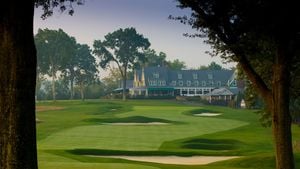Contributed by Matthew Hanks, Hanks Realty Group Realtor
Oakmont Country Club, founded in 1903 near Pittsburgh, stands as one of America’s oldest and most revered golf venues. Designed by Henry C. Fownes and hand‑excavated with over 150 workers, it officially opened in the fall of 1904 as a mammoth par‑80 layout.
Over the decades, Oakmont has hosted more U.S. Opens (ten, including 2025) than any other course, along with a slew of USGA events—PGA Championships, U.S. Women’s Opens, Amateurs, and NCAA tournaments.
With its punishing greens, maze of bunkers, and narrow fairways, Oakmont is a true test of golfing mastery. But beyond the legends and lore, here are 10 little‑known gems that make it truly unique:
1. Once a Par‑80 Monster
When it debuted, Oakmont featured an astonishing par of 80—far higher than today’s par‑71 design. It featured five par‑5s; now those holes are reclassified, and the course plays to a par‑70/71 for the modern U.S.
2. Split by the Pennsylvania Turnpike
A rare feature: the course is bisected by the Pennsylvania Turnpike. Seven holes lie east, eleven west. Two charming footbridges—built in 1920 and widened in the 1990s—connect the two sides.
3. Record‑Setting Clubhouse Lockers
Oakmont’s clubhouse lockers are mammoth. Originally meant for weekend golfers arriving via train, they included secret Prohibition‑era compartments—small lockers within lockers to stash illicit alcohol.
4. Women’s Lockers Get AC
In a quirky twist, the historic women’s locker room is air-conditioned, while the men’s is not—by design, a nod to Oakmont’s “tough‑as‑nails” ethos.
5. Greens Close‑Mown to the Bone
The greens are mowed at less than a tenth of an inch—reportedly the fastest ever measured on site, even surpassing Augusta National.
6. Historic Green‑Speed Testing
Oakmont scientist Stimpson pioneered devices to test green speed. His work inspired the USGA to adopt rigorous testing methods, first used in 1976 national championships.
7. National Historic Landmark
Designated in 1987, Oakmont was recognized as the “oldest top-ranked golf course in the U.S.” and one of the nation’s most historically significant.
8. Weaponized Bunkers
About 175 bunkers—many deep and punishing—dot the course. Among them, the iconic “Church Pews” bunker guards holes 3 and 4, forcing precision off the tee.
9. Johnny Miller’s 63
Oakmont was the site of Johnny Miller’s legendary final-round 63 at the 1973 U.S. Open—considered one of the greatest rounds in tournament history.
10. Anchor Site for the USGA
In 2021, the USGA designated Oakmont one of its two permanent “anchor” U.S. Open venues—alongside Merion—guaranteeing future championships here through 2049.
A Brief Timeline
- 1903–04: Henry Fownes designs and opens Oakmont as a par‑80 challenge.
- 1927: Hosts its first U.S. Open (won by Tommy Armour).
- 1953–73: Hosts major moments — Ben Hogan’s 1953 win; Miller’s 1973 brilliance .
- 2007: Greens slowed after ultra-fast speeds challenge players
- 2016: Dustin Johnson wins the ninth Open at Oakmont.
- 2025: The grand return—Oakmont hosts its record‑setting 10th U.S.
Why Oakmont Endures
There’s more here than slope, greenspeed, or bunker depth—it’s the character and authenticity. From the ancient clubhouse lockers to the roaring crowds paddling across the Turnpike bridge, Oakmont embodies golf’s grand past and rigorous test. Champions who triumph here earn a badge of honor.
Final Thoughts
Oakmont Country Club isn’t just a golf course—it’s a living museum. Its rich tapestry—from par‑80 origins to its enduring spot as the USGA’s anchor site—continues to shape the game. These lesser-known facets—big lockers, secret Prohibition caches, women’s air‑conditioned locker room—add charm, context, and depth to its legendary reputation.
If you’ve only seen Oakmont on TV during U.S. Opens, scratch beyond the bunker lines and fairways—you’ll uncover stories that echo through golf’s history.





